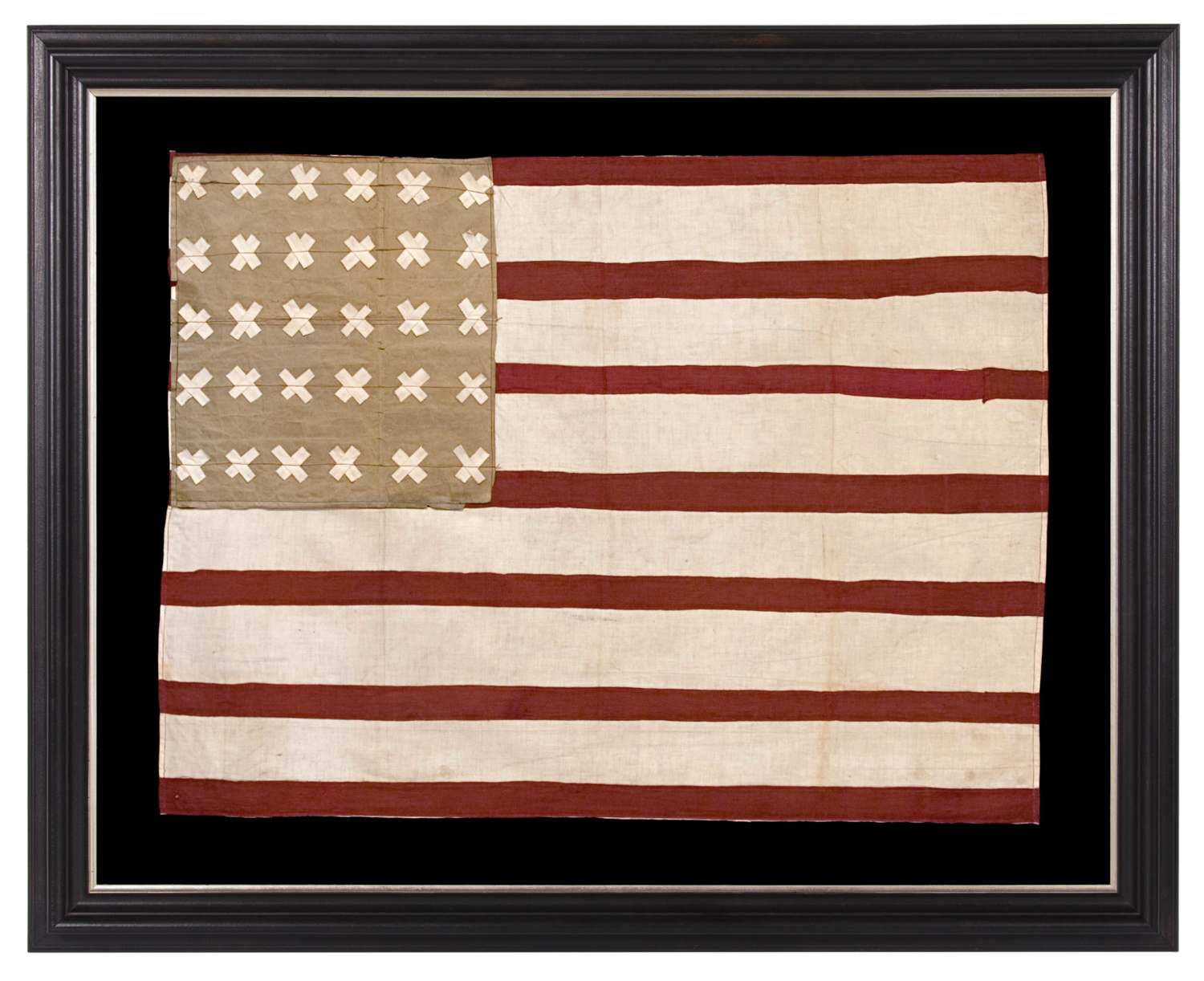
| |
WWI, BELGIAN-MADE VERSION OF THE STARS & STRIPES WITH 30 CROSS-HATCH STARS, USED TO WELCOME U.S. SOLDIERS INTO THE CITY OF VIRTON, BELGIUM IN 1918, FOLLOWING ITS LIBERATION FROM GERMAN OCCUPATION |
|
| Available: |
Sold |
| Frame Size (H x L): |
Approx. 41.5" x 51" |
| Flag Size (H x L): |
29.5" x 39.25" |
|
| Description....: |
|
This 30 star flag was homemade by a Belgian citizen (or citizens) during WWI to welcome the US troops when they entered the city of Virton, five days after German evacuation. It’s wonderful, make-do construction is indicative of American flags made in Europe during both WWI and WWII. Foreigners or Americans made them out of recycled materials since shortages were a byproduct of war. The stars of the flag are simple, cross-hatched X’s made from what appears to be medical tape, and the canton is made of heavy paper, possibly from a file folder or a lightweight storage box. There probably wasn’t time to search for blue cloth or to cut out and appliqué stars, but medical supplies were too often close at hand.
The maker of the flag obviously did not know the number of stars it was supposed to have, but he or she did get their justified configuration correct. Like many flags made in haste, it is one-sided. The background is a white cotton panel, to which the paper canton and cross-hatch stars are glued and sewn by machine. Strips of gabardine wool were then applied to create the red stripes, which are much narrower than their resulting white counterparts. When accompanied by the flag’s other crude yet interesting attributes, the overall result is one of the best displays of folk art in early flag-making that I have ever encountered.
The flag was accompanied by a note that read:
“This flag was made by the Belgians and was flying above the city hall in Virton in honor of the arrival of the American troops, 5 days after the evacuation by the Germans. Because of a shortage of dye-stuffs, a part of the flag is made of paper. The flag was forwarded by Lt. Richard French who was formerly Asst. Treasurer in the Longabre Theatre."
Virton is located in Belgium's Luxembourg Province, at its southernmost point. The province borders the country of Luxembourg to the east, and France to the south and west. Virton itself is along the French border. On August 22, 1914, at the very onset of the First World War, hundreds of Virton's inhabitants were summarily executed by the invading German army. By November of that year, almost all of Belgium was occupied and its civilians were officially classified as prisoners of the German military. The occupation and what is locally known as "The Rape of Belgium" took place over the following 4 years. Unlike WWII, where the Germans were defeated, captured, and/or chased out, during WWI they continued to occupy foreign lands after the war ended. The Armistice, signed on November 11th, 1918, specified that German troops were ordered to evacuate the country in an orderly fashion, the treaty having set a timescale for the withdrawal. All the same, incoming U.S. Marines in Belgium were viewed as liberators as they moved through the country on their way to the Rhine, behind the German retreat.
As a side note, Virton didn't make out especially well during WWII either, when mass deportations took place.
Mounting: The flag was mounted and framed within our own conservation department, which is led by expert staff. We take great care in the mounting and presentation of flags and have preserved thousands of examples.
The background is 100% cotton twill, black in color. The black-painted and hand-gilded molding is Italian. The glazing is U.V. protective plexiglass. |
|
|
|
| Collector Level: |
Flags for the truest Patriots. My best offerings |
|
| Flag Type: |
Sewn flag |
|
| Star Count: |
30 |
|
| Earliest Date of Origin: |
1918 |
|
| Latest Date of Origin: |
1918 |
|
| State/Affiliation: |
|
|
| War Association: |
WW 1 |
|
| Price: |
SOLD |
|
| |
Views: 866 |
|
|
|

